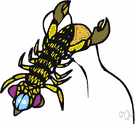
The mucus coating of the fish may be based on sugars rather than proteins. Several theories are given about how they can survive the sea anemone poison: anemone waste products, symbiotic algae) for the anemonefish. These effects may stem from reduced food availability (e.g. Over time, however, there appears to be a down-regulation of metabolism and a reduced growth rate for fish associated with bleached anemones. Bleaching of the host can cause a short-term increase in the metabolic rate of resident anemonefish, probably as a result of acute stress. īleaching of the host anemone can occur when warm temperatures cause a reduction in algal symbionts within the anemone. Aeration of the host anemone tentacles allows for benefits to the metabolism of both partners, mainly by increasing anemone body size and both anemonefish and anemone respiration. Studies on anemonefish have found that they alter the flow of water around sea anemone tentacles by certain behaviors and movements such as "wedging" and "switching". The activity of the anemonefish results in greater water circulation around the sea anemone, and it has been suggested that their bright coloring might lure small fish to the anemone, which then catches them. The nitrogen excreted from anemonefish increases the number of algae incorporated into the tissue of their hosts, which aids the anemone in tissue growth and regeneration. The anemone also picks up nutrients from the anemonefish's excrement. In return, the anemonefish defends the anemone from its predators and parasites. The sea anemone protects the anemonefish from predators, as well as providing food through the scraps left from the anemone's meals and occasional dead anemone tentacles, and functions as a safe nest site. The individual species are generally highly host specific, and especially the genera Heteractis and Stichodactyla, and the species Entacmaea quadricolor are frequent anemonefish partners. 
Symbiosis and mutualism Īnemonefish and sea anemones have a symbiotic, mutualistic relationship, each providing many benefits to the other.

Anemonefish primarily feed on small zooplankton from the water column, such as copepods and tunicate larvae, with a small portion of their diet coming from algae, with the exception of Amphiprion perideraion, which primarily feeds on algae. Diet Īnemonefish are omnivorous and can feed on undigested food from their host anemones, and the fecal matter from the anemonefish provides nutrients to the sea anemone. No anemonefish are found in the Atlantic. Anemonefish typically live at the bottom of shallow seas in sheltered reefs or in shallow lagoons. While most species have restricted distributions, others are widespread. Anemonefish are endemic to the warmer waters of the Indian Ocean, including the Red Sea, and Pacific Ocean, the Great Barrier Reef, Southeast Asia, Japan, and the Indo-Malaysian region.






 0 kommentar(er)
0 kommentar(er)
